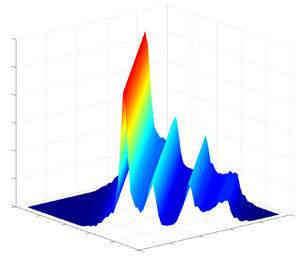Crossref Citations
This article has been cited by the following publications. This list is generated based on data provided by
Crossref.
Zhao, Wenhua
Molin, B.
Wang, Y.
Wolgamot, H.A.
and
Taylor, P.H.
2022.
Nonlinear harmonics of gap fluid resonance with floating body motions.
Journal of Fluid Mechanics,
Vol. 951,
Issue. ,
Gao, Jun-liang
Lyu, Jing
Wang, Jing-hua
Zhang, Jian
Liu, Qian
Zang, Jun
and
Zou, Tao
2022.
Study on Transient Gap Resonance with Consideration of the Motion of Floating Body.
China Ocean Engineering,
Vol. 36,
Issue. 6,
p.
994.
Liang, Hui
Liu, Xiangbo
Chua, Kie Hian
de Mello, Pedro Cardozo
and
Choo, Yoo Sang
2022.
Wave actions on side-by-side barges with sloshing effects: fixed–free arrangement.
Flow,
Vol. 2,
Issue. ,
Gao, Junliang
Gong, Shukai
He, Zhiwei
Shi, Huabin
Zang, Jun
Zou, Tao
and
Bai, Xu
2023.
Study on Wave Loads during Steady-State Gap Resonance with Free Heave Motion of Floating Structure.
Journal of Marine Science and Engineering,
Vol. 11,
Issue. 2,
p.
448.
Song, Zhiwei
Lu, Lin
Tang, Guoqiang
Lou, Xiaofan
and
Liu, Yong
2023.
On the nonlinearity of piston-mode gap resonance.
Communications in Nonlinear Science and Numerical Simulation,
Vol. 125,
Issue. ,
p.
107372.
Jing, Penglin
He, Guanghua
Chen, Bangqi
Zhang, Cheng
and
Ng, Bingfeng
2023.
Effects of roll motion on linear and nonlinear gap resonances in a moonpool excited by various incident-wave heights.
Physics of Fluids,
Vol. 35,
Issue. 10,
Jing, Penglin
He, Guanghua
Ghassemi, Hassan
and
Luan, Zhengxiao
2023.
Transient responses of the linear and nonlinear gap resonances in the fixed and free-heaving moonpools.
Physics of Fluids,
Vol. 35,
Issue. 8,
Zou, Meiyan
Chen, Mingsheng
Zhu, Ling
Li, Lin
and
Zhao, Wenhua
2023.
A constant parameter time domain model for dynamic modelling of multi-body system with strong hydrodynamic interactions.
Ocean Engineering,
Vol. 268,
Issue. ,
p.
113376.
Jing, Penglin
Cui, Ting
He, Guanghua
Zhang, Cheng
and
Luan, Zhengxiao
2024.
Effects of multi motion responses and incident-wave height on the gap resonances in a moonpool.
Physics of Fluids,
Vol. 36,
Issue. 1,
Song, Zhiwei
Mi, Chenglong
Zhou, Zhongbing
Gao, Junliang
and
Liu, Yingyi
2024.
Two-dimensional viscous study of coupled nonlinear fluid resonances in two narrow gaps.
Physics of Fluids,
Vol. 36,
Issue. 10,
Yu, Jun
Cheng, Xiaoming
Xie, Chunmei
Lu, Zhen
Ding, Aibing
Wang, Xuefeng
and
Zhao, Jing
2024.
Hydrodynamic analysis of three-module semi-submersible platform and its mooring design.
Ocean Engineering,
Vol. 310,
Issue. ,
p.
118576.
Jing, Penglin
He, Guanghua
Yang, Kaibo
Minoura, Munehiko
and
Xie, Binyang
2024.
Effects of gap entrance configuration on gap resonances between two free-heaving barges: Higher-order harmonics.
Physics of Fluids,
Vol. 36,
Issue. 10,
Jing, Penglin
He, Guanghua
Zhang, Cheng
He, Runhua
and
Zhang, Zhigang
2024.
Effects of nonlinearities on the gap resonances between two free-heaving barges.
Physics of Fluids,
Vol. 36,
Issue. 4,
Lynggård Hansen, Christine
Bredmose, Henrik
Vincent, Maude
Steffensen, Stefan Emil
Pegalajar-Jurado, Antonio
Jensen, Bjarne
and
Dixen, Martin
2024.
Resonant response of a flexible semi-submersible floating structure: experimental analysis and second-order modelling.
Journal of Fluid Mechanics,
Vol. 982,
Issue. ,
Ding, Haoyu
Gao, Junliang
and
Zang, Jun
2024.
The Impact of Heave Motion on Gap Resonance in Floating Structures: A Numerical Investigation.
Water,
Vol. 16,
Issue. 24,
p.
3644.
Mi, Chenglong
Gao, Junliang
Song, Zhiwei
and
Liu, Yingyi
2025.
Hydrodynamic wave forces on two side-by-side barges subjected to nonlinear focused wave groups.
Ocean Engineering,
Vol. 317,
Issue. ,
p.
120056.
Ding, Yue
Taylor, Paul H.
Hlophe, Thobani
and
Zhao, Wenhua
2025.
A comparison of linear and nonlinear 3D semi-Lagrangian motion of moored Waverider and Spotter wave buoys.
Coastal Engineering,
Vol. 196,
Issue. ,
p.
104661.
Song, Zhiwei
Lou, Xiaofan
Jin, Yan
and
Liu, Hao
2025.
Time-dependent nonlinear fluid oscillations in the gap between two side-by-side ships during transfer.
Physics of Fluids,
Vol. 37,
Issue. 1,
